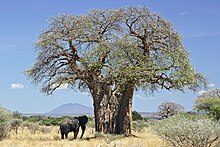Adansonia digitata
Adansonia digitata, the African baobab, is the most widespread tree species of the genus Adansonia,[2] the baobabs, and is native to the African continent and the southern Arabian Peninsula (Yemen, Oman). These are long-lived pachycauls; radiocarbon dating has shown some individuals to be over 2,000 years old. They are typically found in dry, hot savannas of sub-Saharan Africa,.[3] where they dominate the landscape and reveal the presence of a watercourse from afar. They have traditionally been valued as sources of food, water, health remedies or places of shelter and are a key food source for many animals. They are steeped in legend and superstition. In recent years, many of the largest, oldest trees have died, for unknown reasons. Common names for the baobab include monkey-bread tree,[4] upside-down tree, and cream of tartar tree.
| African baobab | |
|---|---|

| |
| Mature, flowering tree in Tanzania | |
| Scientific classification | |
| Kingdom: | Plantae |
| Clade: | Tracheophytes |
| Clade: | Angiosperms |
| Clade: | Eudicots |
| Clade: | Rosids |
| Order: | Malvales |
| Family: | Malvaceae |
| Genus: | Adansonia |
| Species: | A. digitata
|
| Binomial name | |
| Adansonia digitata | |
| Synonyms[1] | |
| |
References
change- ↑ "Adansonia digitata L." Plants of the World Online. Royal Botanic Gardens, Kew. Retrieved 19 February 2022.
- ↑ Wickens, G.E. (2008-03-02). The Baobabs: Pachycauls of Africa, Madagascar and Australia. Berlin] [New York: Springer Science & Business Media. pp. 31–. ISBN 978-1-4020-6431-9.
- ↑ Baum, David A. (1995). "A Systematic Revision of Adansonia (Bombacaceae)". Annals of the Missouri Botanical Garden. 82 (3). Missouri Botanical Garden Press: 440–471. doi:10.2307/2399893. ISSN 0026-6493. JSTOR 2399893.
- ↑ Patrut, Adrian; Woodborne, Stephan; von Reden, Karl F.; Hall, Grant; Hofmeyr, Michele; Lowy, Daniel A.; Patrut, Roxana T. (2015-01-26). "African Baobabs with False Inner Cavities: The Radiocarbon Investigation of the Lebombo Eco Trail Baobab". PLOS ONE. 10 (1): e0117193. Bibcode:2015PLoSO..1017193P. doi:10.1371/journal.pone.0117193. ISSN 1932-6203. PMC 4306539. PMID 25621989.